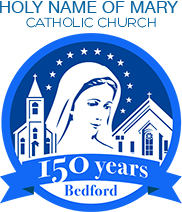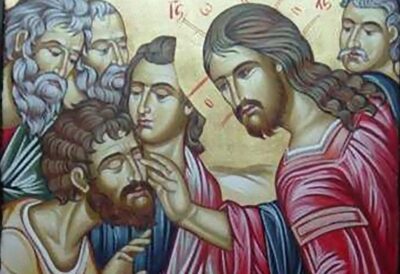Fourth Sunday of Lent
March 19, 2023 — Year A
Readings: 1 Sm 16:1b, 6-7, 10-13a / Ps 23 / Eph 5:8-14 / Jn 9:1-41
by Rev. Nixon Negparanon, Pastor
Our gospel today is about a man who was born blind. What a privilege for the blind man to have met Jesus and be healed by Him! What a privilege for him to have Jesus touch his eyes and bring him sight! Yet who would think that a paste of clay put on one’s eyes and then washing in the Pool of Siloam would restore the blind man’s sight? But Jesus worked through clay and water. Jesus used ordinary elements around us in nature to convey his healing power. Jesus gave the gift of sight by using matter. The blind man could feel the paste of clay on his eyes; he could feel Jesus touching his eyes; he could hear Jesus. He could feel the water washing off the clay. He could not see Jesus, but Jesus came to him through touch and hearing.
In the first reading God works in a similar way. Samuel, under instructions from God, anointed David with oil, and when he did so, the spirit of the Lord came mightily upon David from that day forward. In the first reading and gospel, God’s power and healing were conveyed through elements of nature applied to the body and were conveyed through matter.
So, when Jesus comes to us, how does He come? Every time we receive the sacraments, Jesus comes to us, and there is a visible sign of Jesus coming to us invisibly through His sacrament. Just as the Holy Spirit came mightily upon David when he was anointed with oil by Samuel, and just as Jesus used matter of clay and water for the healing of the blind man, Jesus comes to us in each sacrament with matter used together with prayer, and we call the prayer “the form.” So the matter and form of every sacrament is the visible sign of Jesus coming to us invisibly, but powerfully, in the sacrament.
In the Sacrament of Baptism, the matter is water, which is poured over the head to baptize and symbolizes washing. And the form is that the priest will say the name of the person or the baby, and then continue by saying, “I baptize you in the name of the Father, and of the Son, and of the Holy Spirit,” which is prayed at the same time as the water is poured.
In the Sacrament of Confirmation, the matter is the bishop using his thumb to anoint the forehead with Oil of Chrism. And the form is that he says the name of the person and says, “Be sealed with the gift of the Holy Spirit.”
In the Sacrament of the Eucharist, the matter is bread made from wheat and wine fermented from grapes. The form is the words of the Consecration at Mass over the bread and wine. “Take this, all of you, and eat it. This is my body which will be given up for you. Take this, all of you, and drink from it. This is the cup of my blood, the blood of the new and everlasting covenant.”
In the Sacrament of Reconciliation, the matter is not something that we can see as in the other Sacraments, or something that touches our senses. Instead, it is our sorrow and repentance and the penance we perform after receiving the absolution. The form is the words of absolution prayed over us by the priest, which conclude, “And I absolve you from your sins in the name of the Father (the priest makes the sign of the cross), and of the Son, and of the Holy Spirit.”
In the Sacrament of the Anointing of the Sick, the matter is the anointing with the Oil of the Sick on the forehead and on the palms of the hands. The form is a prayer prayed by the priest at the same time, when he says, “Through this Holy Anointing, may the Lord, in His love and mercy, help you through the grace of the Holy Spirit.” Then he anoints the forehead, and he continues by saying, “May the Lord who frees you from sin save you and raise you up.” Then he anoints the palms.
In the Sacrament of Holy Orders, in which deacons, priests, and bishops are ordained, the matter is the laying on of hands by the bishop on the head of the man being ordained. The form, the prayer of consecration immediately following the laying on of hands, differs on whether it is a deacon, priest, or bishop who is being ordained.
In the Sacrament of Matrimony, the matter and form of the Sacrament is the mutual self-giving and self-acceptance by the couple as they hold each other’s right hand.
When David was chosen by God as King, the spirit of the Lord came mightily upon him when he was anointed by Samuel with oil. When the blind man was healed by Jesus, the healing of Jesus came to him through being anointed with a paste of clay and washed in the Pool of Siloam. He could feel the paste of clay on his eyes, he could feel Jesus touching his eyes, he could hear Jesus, he could feel the water washing off the clay. He could not see Jesus, but Jesus came to him through touch and hearing.
Every time we receive the sacraments, Jesus comes to us by touching our senses, and there is a visible sign of Jesus coming to us invisibly in these sacraments. Who would think that anointing with oil would be the signal for the spirit of the Lord to fall mightily on David? Who would think that anointing with a paste of clay and washing would restore sight?
But God uses ordinary elements of nature to convey His power and healing to us in the sacraments, and in every sacrament, Jesus comes to us invisibly, but powerfully. So, as you receive the sacraments, you hear Jesus and Jesus touches you. Jesus touched the blind man and Jesus touches you when you receive the sacraments.
 540-586-8988
540-586-8988 

